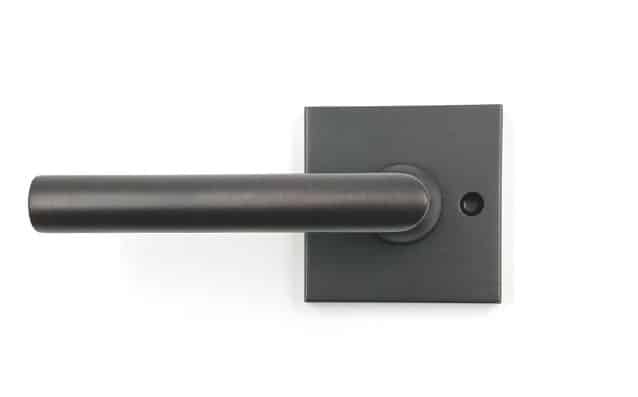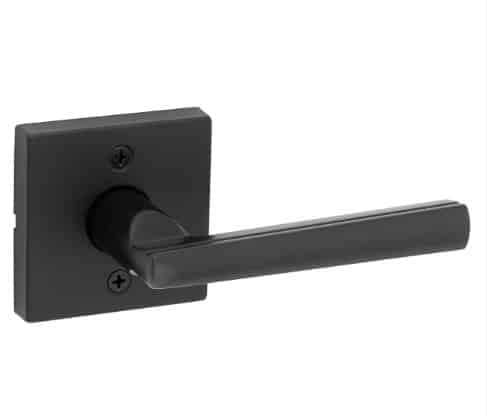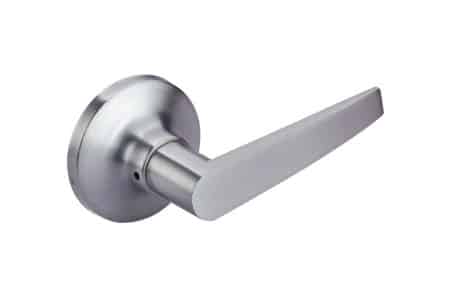A dummy door lever is a non-functioning lever that is installed on a door for decorative purposes or to create a uniform look with other doors in the building. Dummy door levers are commonly used on closet doors, pantry doors, and french doors that do not require a lock or latch.
They are available in a variety of designs and finishes, such as brass, chrome, nickel, and bronze, to match the decor of the room. When choosing a dummy door lever, it is important to consider the overall style of the room and the other hardware that is used in the space.
The right dummy lever can add a touch of elegance to a room and enhance its aesthetic appeal.

Understanding The Basics Of A Dummy Door Lever
If you’ve ever been to a home improvement store, you’ve likely seen all kinds of door hardware, including door knobs, levers, and handles. One type of hardware you may have seen but not fully understood is a dummy door lever.
In this section, we’ll go over the definition and purpose of a dummy door lever, as well as how it differs from a regular door lever.
Definition And Purpose Of A Dummy Door Lever
A dummy door lever is a type of hardware that is installed on a door but doesn’t actually turn or operate any latches or locks. Instead, it’s simply a decorative piece that is used to match the style of other functioning door levers or handles in a room or house.
The purpose of a dummy door lever is to provide a consistent look throughout a space without the need for every door to have functioning hardware. It’s typically used on things like closet or pantry doors, where no locking mechanism is needed but a cohesive look is desired.
How It Differs From A Regular Door Lever
While a dummy door lever may look like a regular door lever, it does not have any functional parts. Here are a few key ways that dummy door levers differ from their functioning counterparts:
- No lock or latch: As mentioned, dummy door levers do not have any internal mechanisms that operate a lock or latch.
- No strike plate: When you install a regular door lever, you’ll also need to install a strike plate on the door frame. A dummy door lever doesn’t require a strike plate, as it does not have anything to latch onto.
- Easier installation: Without any internal mechanisms, dummy door levers are typically easier to install than regular door levers.
- Lower cost: Because there are no functional parts, dummy door levers are often less expensive than regular door levers.
Now that you understand the basics of a dummy door lever, you can make an informed decision about whether it’s the right type of hardware for your doors.
Whether you’re looking for a decorative touch or simply want a consistent look throughout your home, there’s a dummy door lever out there that’s perfect for you.
What Is A Dummy Door Lever Used For?
A dummy door lever is used for decorative purposes and does not have a functional latch. It is typically installed on one side of a door to maintain a consistent appearance while allowing for a cohesive design in non-operable situations, such as closets or pantry doors.
Types Of Dummy Door Levers
Dummy door levers are a type of door handle that cannot turn as they are not connected to a latching mechanism or lock. They are mainly used for decorative purposes and to maintain consistency in the design of doors in a building.
There are several types of dummy door levers, and each one comes with its own design and mounting options. In this section, we will discuss the four most common types of dummy door levers: surface-mounted, flush-mounted, tubular, and rim.
Surface-Mounted
Surface-mounted dummy door levers are the most common type of dummy door lever. These levers mount onto the surface of the door and do not require any special installation. They are perfect for doors that do not have enough depth for other types of dummy door levers, such as flush-mounted levers.

Surface-mounted dummy door levers come in different designs and finishes, which can complement the existing decor of the room. Some key points to note about surface-mounted dummy door levers include:
- Easy to install
- Does not require any special installation
- It comes in different designs and finishes
- Ideal for doors with little depth
Flush-Mounted
Flush-mounted dummy door levers are installed directly into the door, making them a perfect option for doors with a slim profile. This type of dummy door lever provides a clean, streamlined look that does not protrude from the door’s surface.

Flush-mounted dummy door levers come in different designs and finishes, and they provide a seamless look that can complement the door’s overall design. Some key points to note about flush-mounted dummy door levers include:
- Installed directly into the door
- Provides a clean and streamlined look
- Perfect for doors with a slim profile
- Comes in different designs and finishes
Tubular
Tubular dummy door levers are installed into the door with a mounting plate that screws onto the door’s face or edge. This type of dummy door lever is available in different designs and finishes that can complement the door’s design.

Some key points to note about tubular dummy door levers include:
- Installed with a mounting plate that screws onto the door
- Comes in different designs and finishes
- Provides a sleek and stylish look for doors
Rim
Rim dummy door levers are installed on the door’s surface and are mounted on a rim lock or latch. Rim dummy door levers come in different designs and finishes, and they match the design of the rim lock or latch.

This type of dummy door lever is ideal for doors that have a rim lock or latch already installed. Some key points to note about rim-dummy door levers include:
- Mounted on a rim lock or latch
- Matches the design of the rim lock or latch
- Comes in different designs and finishes
- Ideal for doors with a rim lock or latch already installed
There are different types of dummy door levers available, and one should choose the type that best suits their needs. Surface-mounted, flush-mounted, tubular, and rim dummy door levers are the most common types available on the market.
Each of these types has its own unique features and benefits that can complement the design of the door.
What Is Dummy Trim For Doors?
Dummy trim for doors refers to decorative door hardware, such as handles or knobs, that is not functional but is installed for aesthetic purposes. It provides a cohesive look to the door without actually serving as a working mechanism.
What Is A Trimless Door Frame?
A trimless door frame is a door frame design that lacks traditional molding or trim. It provides a sleek and minimalist appearance, seamlessly blending with the surrounding wall for a modern and clean look.
What Is A Dummy Interior Door Handle?
A dummy interior door handle is a non-functional, decorative door handle that is typically used for aesthetic purposes. It is installed on a door where no latching or locking mechanism is needed, providing a consistent appearance for decorative purposes.
Choosing The Right Dummy Door Lever
Your dummy door lever selection is important when it comes to enhancing the overall look and functionality of your doors. A dummy door lever is a non-functioning lever that is bolted to the door. It’s commonly used for decorative purposes or to match with a functioning lever already in place.
Here are some key factors to consider when selecting the right dummy door lever:
Compatibility With Your Door
Before selecting your dummy door lever, it’s important to take note of its compatibility with your door. Consider the following:
- The thickness of your door: most dummy door levers are compatible with doors up to 1-3/4 inch thick; however, some models may require additional pieces for thicker doors.
- Door prep: check that your door has the correct prep for the dummy lever installation. Common types of prep include cross bore and edge bore.
Material, Finishes, And Styles Available
Along with the compatibility, you should also think about the design of the dummy lever. You can choose from a variety of materials, finishes, and styles to match your decor and personal preference. Here are some options to consider:
- Material: Dummy levers can be made of different materials, such as bronze, stainless steel, and brass, enhancing your door’s durability and overall appeal.
- Finishes: You can choose different finishes, such as polished, satin, or antique. Be sure to select a finish that complements your door and interior design.
- Styles: Choose from a wide variety of styles, such as contemporary, traditional, or rustic, that match your preference and style.
Other Considerations
Below are some additional considerations you may want to make:
- Functionality – although dummy levers do not function as real levers, some models may come with additional features such as a push-button or turn mechanism.
- Brand reputation and warranty – choose a trusted brand with an excellent reputation and warranty to ensure the authenticity and longevity of the product.
To sum up, by considering the compatibility, material, finishes, and styles available, along with other important factors, you’ll be able to select the perfect dummy door lever to enhance your door’s overall design and functionality.
How Do I Install A Dummy Door Lever?
Door levers come in various styles and designs, depending on where they’re being used. A dummy door lever is a type of lever installed mainly on doors that don’t have a latch but have a decorative purpose. Installing a dummy door lever is not as challenging as you might imagine.
Here are the key points, materials, and steps required for a successful installation.
Tools And Materials Needed
Before beginning, make sure you have the right tools and materials required for the job. Here is a list of what you’ll need:
- Dummy door lever
- Screws and screwdriver
- Measuring tape
- Pencil
Step-By-Step Guide To Installing A Dummy Door Lever
- First, begin by determining the right place to install your door lever. Generally, you want to install your door lever at an estimated height of 36 inches from the floor. Once you have measured the distance, mark the spot with a pencil.
- Once you have determined the location where the door lever will be installed, hold the lever against the door to make sure the spot is the right one.
- Now it’s time to install the mounting plate. Place the mounting plate at the back of the door lever and screw it using the screws provided.
- Next, it’s time to install the door lever. Place the lever on the mounting plate, align it perfectly, and tighten the screws.
- Finally, test the door lever to make sure it works perfectly. If it operates smoothly, then you’ve successfully installed your dummy door lever.
Precautions To Take While Installing
While you install the dummy door lever, ensure you avoid these common reasons that lead to inefficiencies:
- Always double-check before fixing the screws to ensure they’re in the right place.
- Avoid over-tightening the screws, as it may damage the mounting plate or cause the door lever to not function correctly.
- Make sure all the screws are secure when you finish the installation.
By following these simple steps, you can install a dummy door lever quickly and easily, with minimum effort.
Tips For Maintaining Dummy Door Levers
Dummy door levers add a touch of elegance and charm to any room. They are often installed in hallways, closets, or on the non-latching side of any door. They do not have a lock and are mainly used for decorative purposes.
However, just like any other door lever, dummy door levers also require maintenance. Here are some tips for maintaining dummy door levers.
Best Practices For Cleaning And Maintaining Your Dummy Door Lever
To prolong the life of your dummy door lever and keep it in good condition, follow these cleaning and maintenance tips:
- Clean your dummy door lever at least once a week with a soft, damp cloth to remove any dust or grime.
- Avoid using abrasive cleaners or chemicals, as these can damage the finish of your dummy door lever.
- If there are stubborn stains or marks on your dummy door lever, use a mild cleaning solution and a soft-bristled brush to gently scrub the affected areas.
- Apply a small amount of oil to the moving parts of your dummy door lever, such as the handle and hinges, to keep them moving smoothly.
Common Issues And How To Troubleshoot Them
Like any mechanical device, dummy door levers can develop some common issues. Here are some of the common issues and how to troubleshoot them:
- Loose screws: Over time, the screws holding the dummy door lever in place can become loose. Tighten these screws with a screwdriver to secure the lever in place.
- Stuck lever: If the lever becomes stuck and does not move smoothly, check for any debris or dust in the lever mechanism. Clean out any debris and apply some oil to the moving parts.
- Damaged finish: If the finish of your dummy door lever becomes damaged, you may need to replace the lever. However, in some cases, you can touch up minor scratches with a touch-up paint pen.
Replacing A Faulty Dummy Door Lever
If your dummy door lever is beyond repair, you will need to replace it. Here are the steps to follow when replacing a faulty dummy door lever:
- Remove the screws holding the old dummy door lever in place and pull the lever away from the door.
- Insert the new dummy door lever into the bore hole and secure it in place with screws.
- Test the new dummy door lever to make sure it is working correctly.
Maintaining your dummy door lever is easy if you follow these tips. By taking care of your dummy door lever, you can ensure that it looks great and works smoothly for many years.
Frequently Asked Questions For What Is A Dummy Door Lever?
What Is A Dummy Door Lever Used For?
A dummy door lever is a non-functional handle that is typically used for decorative purposes on fixed doors.
Can A Dummy Door Lever Be Installed On A Functional Door?
Yes, a dummy door lever can be installed on a functional door, but it will not have any mechanical function.
How Do You Install A Dummy Door Lever?
To install a dummy door lever, you will need to remove any existing hardware and replace it with the decorative lever using screws.
What Types Of Materials Are Used To Make Dummy Door Levers?
Dummy door levers can be made from a variety of materials, including brass, stainless steel, zinc, and porcelain, among others.
Conclusion
After exploring what dummy door levers are, it is clear that these devices serve a useful purpose in the home and workplace. Whether it’s for aesthetic purposes or to simply maintain privacy, dummy door levers are a necessary addition to any door where a functioning handle is not required.
It’s important to note that dummy levers are not just limited to one style or design, but can come in a range of finishes and materials to match any décor. By understanding the benefits of a dummy door lever, homeowners and businesses can make informed decisions when it comes to securing their property and ensuring the safety and privacy of those inside.
With all of their unique qualities, dummy door levers are an impressive innovation in the world of door hardware and are worth considering for your next home or office upgrade.
